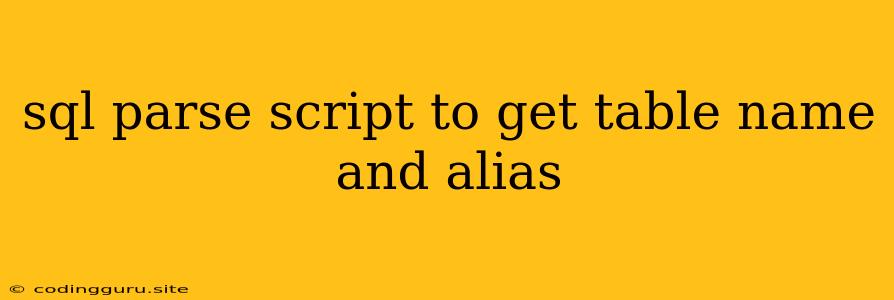Extracting Table Names and Aliases from SQL Scripts: A Comprehensive Guide
Extracting table names and aliases from SQL scripts is a common task for developers and data analysts. Whether you're working with legacy code, optimizing queries, or simply understanding the data flow, identifying table references within a script is crucial. In this article, we'll delve into various techniques to parse SQL scripts and efficiently extract table names and aliases.
The Challenges of Parsing SQL Scripts
SQL scripts can be complex and contain various elements, including:
- Different SQL dialects: Each database system (MySQL, PostgreSQL, SQL Server) might have slightly different syntax variations.
- Nested queries and subqueries: These can make it difficult to distinguish the scope of table references.
- Comments and whitespace: Comments and extraneous whitespace can complicate parsing algorithms.
- Dynamic SQL: Scripts using dynamic SQL (e.g., prepared statements) can make it challenging to identify tables at parsing time.
Strategies for Extracting Table Names and Aliases
Here are some common approaches to extract table names and aliases from SQL scripts:
1. Regular Expressions:
Regular expressions (regex) are powerful tools for pattern matching. You can create specific patterns to capture table names and aliases within your SQL script.
Example:
SELECT \s* ([a-zA-Z0-9_\.]+) \s* AS \s* ([a-zA-Z0-9_\.]+)
This regex would match lines with a SELECT keyword, followed by a table name (captured in group 1) and an alias (captured in group 2), separated by AS.
2. Lexical Analysis:
Lexical analysis involves breaking down the script into tokens (keywords, identifiers, operators, etc.). By analyzing these tokens, you can identify table names and aliases based on their context.
Example:
SELECT * FROM customers AS c WHERE c.id > 10;
A lexical analyzer would identify "customers" and "c" as table names and aliases, respectively.
3. Parsing Libraries:
Several libraries are designed specifically for parsing SQL scripts. These libraries offer robust and efficient parsing capabilities, handling syntax complexities and providing structured information about the script.
Example:
import sqlparse
sql = "SELECT * FROM customers AS c WHERE c.id > 10;"
parsed = sqlparse.parse(sql)
for statement in parsed:
for token in statement:
if isinstance(token, sqlparse.sql.Identifier):
print(token.get_real_name())
This Python code uses the sqlparse library to parse the SQL script and identify identifiers (table names and aliases).
4. Code Transformation:
In some cases, you might want to transform the original script to make extracting table names and aliases easier. This could involve:
- Removing comments: Removing comments can simplify the script and reduce parsing complexity.
- Standardizing whitespace: Consistent whitespace can make patterns easier to recognize.
- Replacing aliases: Replacing aliases with their original table names can provide a more direct view of the table references.
5. Database-Specific Tools:
Some database systems provide tools or functions that can analyze SQL scripts and provide information about table usage.
Example:
In SQL Server, the sp_depends stored procedure can be used to determine dependencies between tables.
Best Practices and Considerations
- Choose the right approach: The best approach depends on the specific script and the desired outcome.
- Handle dynamic SQL: If you're dealing with scripts that use dynamic SQL, you might need additional parsing techniques or access to the database to resolve the actual tables involved.
- Address SQL dialects: Be aware of potential syntax variations across different SQL dialects and ensure your parsing mechanism can handle them.
- Test thoroughly: Test your parsing solutions on a variety of scripts to ensure they accurately extract table names and aliases.
Conclusion
Extracting table names and aliases from SQL scripts is an essential task for developers and data analysts. Several techniques, including regular expressions, lexical analysis, parsing libraries, and code transformation, can be used to achieve this goal. By choosing the right approach and addressing potential complexities, you can effectively parse SQL scripts and gain valuable insights into table references within your code.
